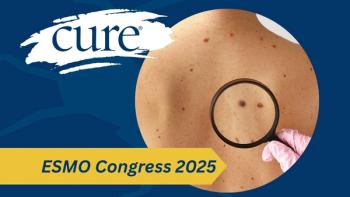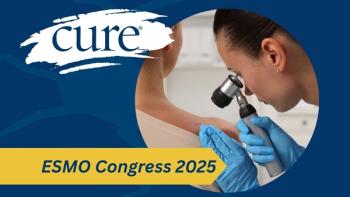
- Summer 2008
- Volume 2
- Issue 2
Seeing the Light
Melanoma survivor and once-devoted tanner spreads the word about skin cancer.
You know you can die young,” Robin Lawrence recalls blurting out to two tanned teens passing her booth at the annual Evansville, Ind., health fair last spring. Lawrence, 47, a former bodybuilder and melanoma survivor, wants this generation’s attention: Melanoma kills.
Health fairs, school lectures, community presentations — Lawrence calculates she’s done 600 appearances since concluding her skin cancer treatment five years ago. After the initial surgery to remove the cancer from her buttocks, she underwent 25 biopsies. As a result, four other melanomas (carcinoma in situ) were removed, as well as 13 atypical moles (dysplastic nevi tumors), all precursors to melanoma.
“Ultraviolet rays and tanning are harmful, and young people should know this now. I wish I had known,” she says. Her fear is that not much has changed since she was a teen. Lawrence’s own daughter, now 20, was tanning with her up until the cancer diagnosis.
The girls at the health fair booth were “very attractive,” says Lawrence. “I didn’t want to scare them. I apologized for the abruptness and handed them materials and sunscreen and told them to be careful.” Maybe they listened. Maybe they read the information. The point, Lawrence says, is that she has done her job.
Lawrence, chatting by phone last winter from her office in Evansville, was preparing to go to San Antonio in February to receive the American Academy of Dermatology’s Gold Triangle Award. It is her third AAD award and one of many public services honors she has received since her advocacy work began.
She crusades tirelessly. Her first day on the job as the director of marketing for the Evansville Cancer Center was March 25, 2002, three days after the news of her own cancer. “There are no coincidences. I was told on a Friday I had cancer. I called the center and asked Dr. [Al] Korba, ‘Do you still want me to come to work?’ He said, ‘You’re one of us, now.’ ” Korba, the recently retired director of the center, is a bladder cancer survivor.
Lawrence travels mostly to area schools and nearby communities, filling up college, high school and middle school auditoriums and classrooms. Part of the advocacy work is professional, but she also uses her own time to speak to organizations and individuals about her cancer experience and the dangers of melanoma. She often takes phone calls from concerned parents, like the mother of a 14-year-old cheerleader who suspected that her daughter was sneaking into a tanning salon. Lawrence’s advice was to find the salon and hold it accountable. “She’s underage, and that’s illegal,” Lawrence says.
The laws vary by state. In Indiana, anyone under 16 visiting a tanning salon must be accompanied by a parent or guardian and have a signed consent form from a parent or guardian. Between ages 16 and 18, only the signed consent is required. Salons that violate the law face fines.
“The fines are not always imposed; however, I want people, parents especially, to know they exist so they can make an informed decision. I wish someone had warned me and my parents,’’ Lawrence says.
Melanoma of the skin is the seventh-most common cancer in women (sixth in men), according to the American Cancer Society, and is the most common cancer in young adults ages 25 to 29. The odds of successful treatment drop drastically when melanoma spreads beyond the skin to other parts of the body, including the lungs, liver and brain. More than 75 percent of skin cancer deaths are from melanoma, translating to about 8,000 deaths a year in the United States.
Lawrence preaches prevention and emphasizes risk factors: “Stay out of the sun from 10 a.m. to 4 p.m. Wear sunscreen, sunglasses with UV protection, hats, long-sleeve clothing and long pants. Don’t use tanning salons.”
As in her day, young people still associate looking good and healthy with being tanned, she says. The fair-skinned, blond-haired, blue-eyed Lawrence admits she was clueless growing up on a farm in southern Indiana. Blonde- and red-haired people with very white skin are more susceptible. But, she says, no one is immune. “People forget [black reggae icon] Bob Marley died of skin cancer in his 30s.” Marley’s melanoma originated in his toe.
As a teen, she obsessed over tanning, pouring on a mix of iodine and baby oil and lying in the sun for hours. As she got into her 20s and into bodybuilding, Lawrence says the need seemed more urgent. She discovered tanning salons.
In March 2002, she had a mole on her face checked out. It took almost three months to see a dermatologist. The mole was an age spot, but a closer look at a mole on her buttocks showed cancer.
“It’s impossible to see a skin specialist immediately unless you are an established patient,” Lawrence laments. “I believe everybody past 40 should have a dermatologist and an annual skin cancer check. We get breast exams and Pap smears. We screen for colon cancer. The skin is the largest organ on our body, and probably the one we pay the least attention to.”
She keeps an arsenal of facts and stats for every question asked. She is determined to change attitudes and lifestyles. There is no choice, she says. With the increasing threats to the ozone layers, there is greater risk of overexposure to the sun. The good news, she points out, is that skin cancer, if detected early, can be very curable.
Lawrence often shows up with a DermaScan machine offering free screening. “I tell people, ‘I’m not a dermatologist. This is a machine that shows you the damage to your skin from UV radiation either from the sun or tanning beds.’ If something shows up on the scan, I urge them to get it checked.’’ (At the 2007 Evansville health fair, 84 were screened and 35 were urged to follow up with a doctor based on what the scans revealed.) She gives a PowerPoint lecture, shows her heart-rending video interview with a 20-something who ultimately lost her battle with melanoma, and provides sunscreen samples and handouts.
Her talk is frank and powerful, says Gloria Schwartz, an Evansville wellness coordinator who helps Lawrence with presentations. Schwartz has observed numerous presentations at the University of Southern Indiana and Indiana Vocational Technical College, where she is an adjunct instructor, as well as in the community.
“The message resonates with young audiences,” says Schwartz, also a melanoma survivor. “Students listen. They become extremely quiet when she’s talking, and you see the wheels turning. At the end of the lectures, they swarm her.”
The annual Evansville health fair takes place in May, which happens to be Skin Cancer Awareness Month. Lawrence says she is as excited about the fifth as she was the first, coordinating plans with other presenters, spreading the word to the community, calling on doctors including her own to provide the complimentary screenings, and working with the mayor and his staff to secure another successful Healthier Evansville Week.
She also is pushing for a sunscreen protection program in Evansville in memory of Southern Indiana basketball star Wesley James Attebury, who died a year ago, three years after being diagnosed with melanoma. He was 28 and left behind a wife and baby.
To read about new, investigational therapies for melanoma, see
There are no coincidences. I was told on a Friday I had cancer. I called the center and asked Dr. [Al] Korba, 'Do you still want me to come to work?' He said, 'You're one of us now.'
Articles in this issue
over 15 years ago
Light by Which to Seeover 15 years ago
Voicesover 15 years ago
Prostate Protectionover 17 years ago
A Mission of Empowermentover 17 years ago
Facing Down the Fearover 17 years ago
Tracing Cancer Connectionsover 17 years ago
To Tell or Not to Tellover 17 years ago
Cancer for the Long Haulover 17 years ago
Supporting the Potential to Healover 17 years ago
Let's Get Moving!




